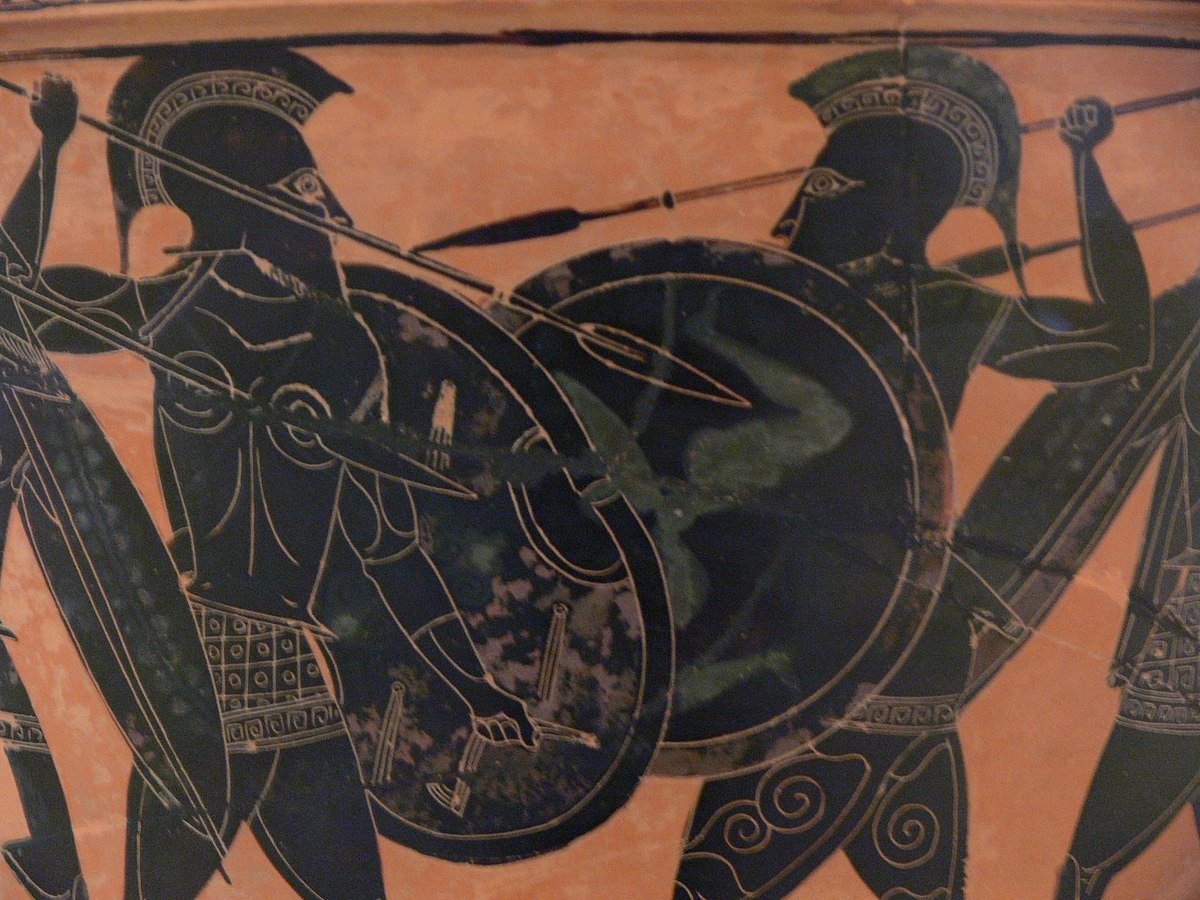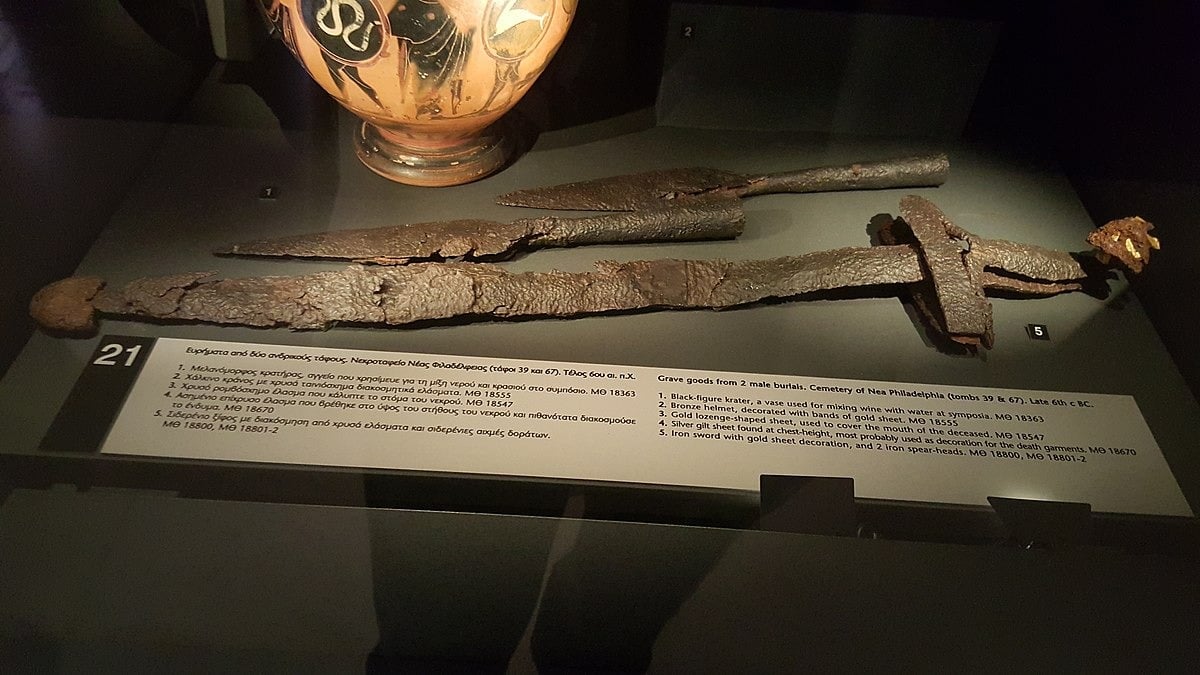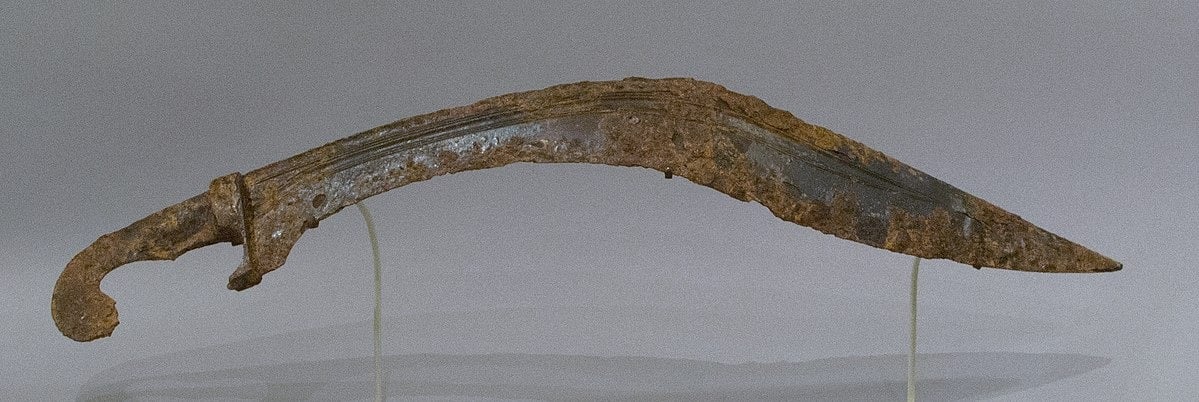
The ancient Greeks used a variety of weapons on the battlefield, each suited to a different purpose. Some were adopted as primary weapons, whereas others were carried into engagements as a backup.
Ancient Greek weapons used in the melee (close-combat fighting) tended to reflect and dictate the formations that different units fought in. For example, the advantages and disadvantages of the traditional hoplite phalanx formation differed from the later Macedonian variation due to the characteristics of the primary weapons used in those formations.
In any case, ancient Greek weapons came in a variety of highly practical designs. Without them, the Greeks may not have been able to thrive across the ancient Mediterranean, which was full of opportunities, but also posed a myriad of threats.
The dory (spear)
The spear was the most ubiquitous ancient Greek weapon. In fact, the spear was the most frequently used weapon in historical warfare until the introduction of firearms.
The standard weapon of an ancient Greek hoplite – the heavily armored infantry of ancient Greece – was the dory. The term dory was first recorded in the work of Homer and is frequently used by the heroes of the Iliad during the Trojan War as a primary weapon.
As explained in one academic paper published in 2020, “The dory simply was invaluable to the hoplite, and his masterful use of it was the reason for his successes.”
Hoplites were typically more heavily armored than their non-Greek adversaries and fought in a densely packed formation called the phalanx. The dory was predominately used as a thrusting weapon but was aerodynamic enough to be thrown like a javelin if the situation called for it.
The speartip was of a flat leaf shape and was typically made of iron or bronze depending on the period. The dory also featured a butt spike called the sauroter which could be spun around and used if the speartip was broken.
The shaft of the spear was usually made of ash or cornel wood and would typically have been between two and three meters long.
Our reenactment of Plataea, the largest and perhaps most historically important battle of the ancient world, begins 25 July in Greece! https://t.co/3gTlFGCEYB is worth a look! pic.twitter.com/RPDmi8fAir
— Miles is writing ‘Breaking Hel’ (@Phokion1) July 1, 2022
The sarissa
The sarissa became the primary weapon of the Macedonian heavy infantry after its adoption by Philip II, the father of Alexander the Great. It was an especially long spear or pike wielded by the Macedonian phalangites in the phalanx formation.
The sarissa was longer than the dory, at about four to six meters in length on average. It was also much heavier at 5.5 to 6.5 kilograms versus the dory which weighed between 0.91 to 1.81 kilograms.
The sarissa offered its user greater reach than other spears and weapons typically used in ancient Greek warfare. The tradeoff was that units using the sarissa tended to be less maneuverable due to the weight and size of their weapons. To overcome this disadvantage, Alexander the Great and other astute military minds would often deploy lighter infantry and cavalry to protect the flanks of the main body of pikemen in the army.
After the death of Alexander, the sarissa continued to be used as the primary infantry armament of the successor states such as the Seleucid Empire and the Ptolemaic Kingdom. It was also adopted by various city-states and leagues.
The xiphos
Xiphos was a relatively general term used by the ancient Greeks to refer to a sword, but in modern historiography it more specifically refers to a double-edged, one-handed shortsword.
For most ancient Greek soldiers, swords like the xiphos would have been a secondary weapon, with the spear being the primary weapon.
On average, a xiphos would have been between 45 and 60 cm long, although the Spartans are reputed to have used shorter swords roughly 30 cm.
These exceptionally short swords might have been useful when two phalanxes met in the “othismos“, roughly translating to “push”. This is when two phalanx formations met at extremely close distances and the hoplites would push against each with their large heavy shields, somewhat comparable to a rugby scrum. Shorter variations of the xiphos may have been more easily slipped between gaps at the exposed parts of an otherwise very well-protected enemy at extremely close range. However, this aspect of hoplite warfare is still hotly debated by historians.

The kopis
The kopis, also sometimes called a machaira, was a single-edged cut-and-thrust sword used by ancient Greek infantry and cavalry. Its most distinctive feature was its forward curvature which made it a powerful cutting weapon.
The weapon’s curvature and suitability for cuts and thrusts made it an excellent weapon for the cavalry, particularly in situations where they were fighting infantrymen who would have stood shorter beneath their horses. Anyone on the receiving end of a downward thrust of the kopis would be having a very bad day indeed.
The ancient Greek soldier and writer Xenophon wrote “I recommend a kopis rather than a xiphos, because from the height of a horse’s back the cut of a machaira will serve you better than the thrust of a xiphos”.

The xyston
The xyston was a long thrusting spear that was between 3.5 to 4.25 m (11 to 14 ft) long. Historians believe that it was usually wielded with two hands and that it could be held with an overhead or underarm grip depending on the situation.
Like the dory, the xyston had a spear point at both ends. This was useful in case the spear was broken but the secondary speartip may have acted as a counterweight to improve the balance of the weapon.
In ancient Greek parlance, the word xyston may have been quite a general term for a spear or even a javelin, as is the case for some of the previously mentioned weapons. For example, the Jewish historian Flavius Josephus referred to the Roman pilum – a type of thrown javelin – as a xyston. However, in modern historiography, a xyston is typically used to refer to the weapon favored by ancient Greek cavalry.
See all the latest news from Greece and the world at Greekreporter.com. Contact our newsroom to report an update or send your story, photos and videos. Follow GR on Google News and subscribe here to our daily email!



